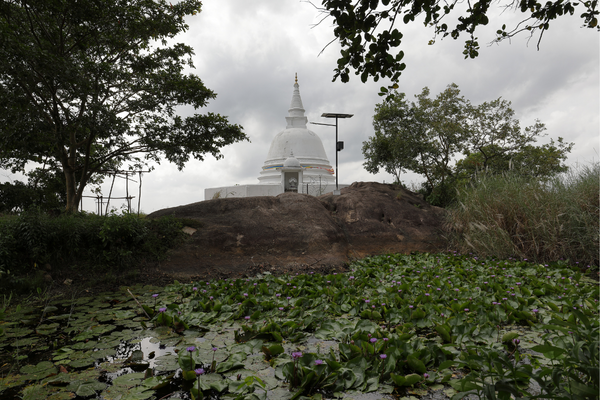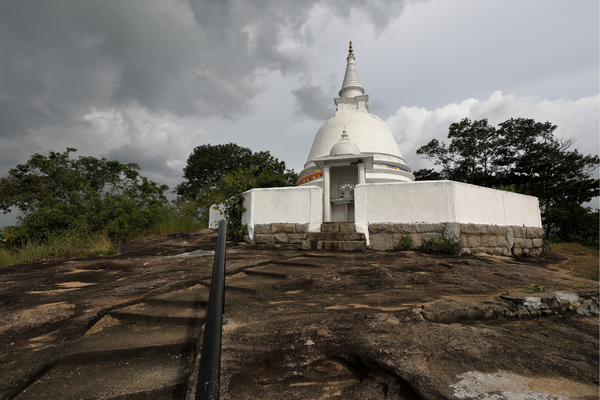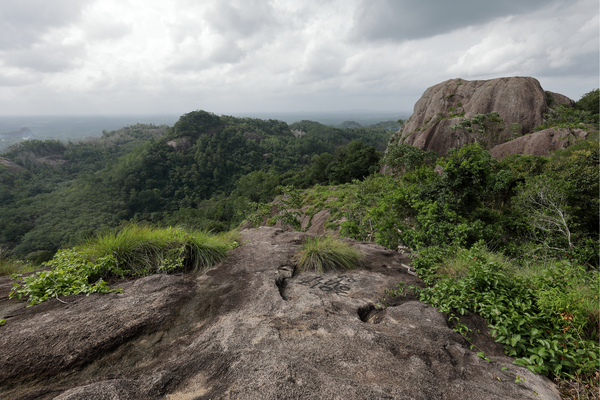Maligatenna: Abode of royals entwined in myths and legends – By Arundathie Abeysinghe

 Panoramic vistas of the surrounding landscape… A picturesque hamlet situated in close proximity to Colombo-Kandy main road…A simple abode of ascetic Buddhist monks of yesteryear…A temple situated amidst rocky mountainous frontiers…
Panoramic vistas of the surrounding landscape… A picturesque hamlet situated in close proximity to Colombo-Kandy main road…A simple abode of ascetic Buddhist monks of yesteryear…A temple situated amidst rocky mountainous frontiers…
Situated in close proximity to the picturesque hamlet of Malwathuhiripitiya (a few kilometers from Yakkala in Gampaha District), Maligatenna Raja Maha Vihara also known as the “Hermitage of Maligatenna” (according to the name board) with ancient rock cave shelters converted as len vihara (rock temples) dating to the Pre-Christian eras of 1st, 2nd and 3rd centuries is a serene temple in a spectacular environment constructed on a ridge.
This sanctified temple had been an abode of *Arhat and meditative bhikkhus. The location has also been a refuge for kings of ancient Sri Lanka who sought sanctuary from enemies, especially invading foreign armies. According to chronicles, *King Walagamba had also stayed in this temple (during his journeys staying in many hideouts throughout the country) to escape invading armies. Maligatenna rocky boulder with caves was one such hideout. He had stayed in this location including in the nearby Warana Temple.
According to scholars, history of the Temple dates to the *Anuradhapura Era.
To reach the upper location (known as “Ihala Maluwa” in Sinhala), it is necessary to climb the stone stairway of neatly cut flight of steps with a handrail. The stupa (dagoba) of the Temple known as “Sri Devaraja Akasha Chaitya Rajaya” has been constructed in 1924 by benevolent devotees whose names are etched on the stupa. At the summit of the Rock near the stupa, there is a rock pond with water lilies, a mesmerizing sight. The Image House (Budu Ge) with vibrant colorful paintings depicting *Jathaka tales and the *Bo-Tree shrine are also unique. To reach the Bo-Tree shrine there is a small scenic walkway lined with two massive natural rock slabs on either side. These features are recent additions to the Temple Complex. Yet, the main drip-ledged cave shrine in the lower terrace depicts the antiquity of the Temple.
Ihala Maluwa (Upper Terrace) of the Temple Complex is considered as the highest point of *Gampaha District. The climb up to this location is strenuous for the average person as the path is bordered by several caves and fitted out with stone steps and rocks at certain places. It is necessary to clutch onto rocks at times. Yet, the elderly devotees climb this location on *poya days. In the middle of the way, there is a gap known as “Old Degaldoru Kurubil” stone steps, a marvelous creation of nature.

According to chronicles, *King Mayadunne had commissioned Diyawadana Nilame (Chief lay custodian of the Sacred Tooth Relic) Hiripitiya Rala to construct a temporary palace in close proximity to Maligatenna Raja Maha Vihara to safeguard the Sacred Tooth Relic from invading enemies.
Scholars are of the view that during the Kingdom of Kotte when the country was under Portuguese influence, there were several kingdoms. As King Don Juan Dharmapala (1551-1597, also known as “Dom Joao Dharmapala Peria Bandara”, the last king of the *Kingdom of Kotte) embraced Christianity, King Mayadunne of *Seethawaka Kingdom, plotted to conceal the Sacred Tooth Relic in Maligatenna Temple.
The Temple is protected by the Department of Archaeology.
Directions: Travel up to Ambagaspitiya junction along Yakkala-Kiridiwela road and turn right and the temple can be seen on a mountain, a serene spectacular location.
- Arhat – According to Buddhism, an Arhat is one who has gained insight into the true nature of existence and achieved *Nirvana.
- Bo Tree – A specific sacred fig tree (Ficus religiosa) also known as “Bodhi Tree” under which the Buddha had attained Enlightenment (when a Buddhist finds the truth about life and stops being reborn as he/she has reached *Nirvana) at Bodh Gaya in Bihar, India.
- Gampaha District – Located in the west of Sri Lanka with an area of 1,387 square kilometers (536 square miles). Gampaha District is one of the 25 districts of Sri Lanka. It is the second most populous district of Sri Lanka.
- Jathaka tales – A voluminous body of literature native to India based on the previous births of the Buddha. According to Peter Skilling, this genre is “one of the oldest classes of Buddhist literature. Jataka tales illustrate the many lives, acts and spiritual practices that are required during the long path to Buddhahood (a title is commonly utilzed for Gautama Buddha, the founder of Buddhism, who is often simply known as “the Buddha”.
- Kingdom of Kotte – This was a kingdom which flourished in the 15th century in Ceylon. The term “Kotte” is believed to have derived from the Sinhalese word kotta and Tamil word kottei, meaning fortress. The word Kotte was introduced by Nissankamalla Alagakkonara, the founder of the fortress. According to legends, Kotte had been founded as a fortress by Minister Alakeswara (1370 -1385).
- King Mayadunne (1501–1581) – According to *Mahawamsa, Mayadunne was the King of the *Kingdom of Sitawaka (1521-1581). King Mayadunne was a fierce opponent of the Portuguese who had arrived in Ceylon in the island, in 1505. He devoted his life attempting to oust his brother King Bhuvanekabahu (ruler of the *Kingdom of Kotte who ruled from 1521-1551) and thereby preserve the independence of the island undermined by the Portuguese intrigue. He constantly invaded the territory of King Bhuvanekabahu of Kotte.
- Kingdom of Sitawaka – A kingdom located in south-central Sri Lanka that emerged from the division of the *Kingdom of Kotte following the Spoiling of Vijayabahu in 1521. According to scolars, King Rajasinghe first took command of the Seethawaka forces at the age of 11 years and fought several battles with Portuguese invaders including the well-known battle, the Battle of Mulleriyawa (considered as part of the Sinhalese–Portuguese War and one of the most decisive battles in the history of Sri Lankan as well as the worst defeat of Portuguese during that period) until his death in 1593.

- King Walagamba (103 BC and c. 89–77 BC) – Also known as “Wattagamani Abhaya” and “Walagambahu”, the King ruled the Anuradhapura Kingdom of Sri Lanka. Five months after becoming king, he was overthrown by a rebellion including an invasion from South India. Yet, 14 years later, he regained the throne by defeating the invaders. Thereafter, he ruled the country for 12 years until his death in 77 BC.
- Mahawamsa – “Great Chronicle” or “Great Dynasty” in Sinhala is the most significant work of Sri Lankan origin written in Pali Language. This Chronicle describes life and times of Sri Lankans from the arrival of Vijaya in 43 BC to the reign of King Mahasena from sixth century BC to fourth century AD. Culavamsa (lesser chronicle) covers the period from fourth century AD to British takeover of Sri Lanka in 1815. Mahavamsa consists of three parts covering a historical record of over two millennia. It is considered as the world’s longest unbroken historical record.
- Nirvana – It refers to a release from the cycle of death and rebirth, the ultimate spiritual goal of Buddhism.
- Poya Day – Poya is the name given to the Buddhist Full Moon Holiday known as “Uposatha” (Buddhist day of religious observance which was in existence from the Buddha’s period to date). There are 13 -14 Poya Days including Adhi (extra in Sinhala) Poya Day per annum. Adhi Poya Day is the second Poya Day of a month as in Adhi Vesak. In Sri Lanka Poya Day is declared as a Public, Bank and Mercantile Holiday.







